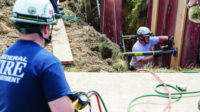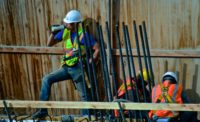Inspectors with the U.S. Department of Labor’s Occupational Safety and Health Administration are switching out their traditional hardhats for more ANSI type II-certified safety helmets. The agency recommends people working in construction consider making a similar move, but has not mandated it.
The change comes after OSHA released a safety and health information bulletin last month detailing advantages of the modern safety helmets with anti-concussion technology compared to traditional hardhats.
“OSHA wants employers to make safety and health a core value in their workplaces and is committed to doing the same by leading by example and embracing the evolution of head protection,” officials wrote in a notice about the change.
As ENR has previously reported, there have been advancements in the design of helmets and the protection they can provide. While helmets equipped with anti-concussion technology such as the Multidirectional Impact Protection System (MIPS), Wavecel or Koroyd systems have seen more adoption overseas, many contractors in the U.S. had been mandating them on their worksites before OSHA made this change in its recommendations.
Head injuries accounted for 5.8% of non-fatal occupational injuries involving days away from work in 2020, according to Bureau of Labor Statistics data cited by OSHA. About a fifth of those cases were caused by slips, trips or falls, which OSHA officials note can cause a hardhat to fall off a worker’s head. Type II helmets include a chin strap that can keep the helmet in place after a slip or a fall and also must feature some protection system for side impacts as opposed to only protecting from impacts from the top, usually from falling objects, as traditional hardhats do.
Hardhats provide minimal side impact protection, according to the bulletin. The type II helmets are made of a combination of lightweight composites, fiberglass and thermoplastics which offer better impact resistance with reduced weight.
Some type II helmets also incorporate eye protection and built-in hearing protection and communication systems, OSHA notes.
Construction sites are one of the recommended use cases for safety helmets OSHA outlined in the bulletin. Officials pointed to the risk of falling objects and debris, impacts from equipment and falls as situations where a safety helmet could provide better impact resistance compared to a hardhat. Contractors such as Clark, Pepper and Clayco, keen to reduce risk on their sites, all mandated type II helmets on their sites before OSHA.






Post a comment to this article
Report Abusive Comment